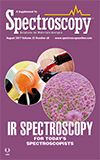Article
Special Issues
Spectroscopy Supplements
Solving Polymer Problems Using IR Spectroscopy
Naoto Nagai focuses on solving problems for industry. In this interview, he explains his research to determine the cause of resin cracks in polyoxymethylene mold plates using IR spectroscopy.
Infrared (IR) spectroscopy is a versatile analytical technique that has found application in a great variety of industries. Naoto Nagai, of the Industrial Research Institute of Niigata Prefecture in Japan, has been studying the potential of IR spectroscopy for investigating higher-order structures of polymers. He and his colleagues recently looked at the IR spectra of polyoxymethylene (POM) mold plates and the cause of occasional resin cracks. Nagai is the 2017 recipient of Sciex’s William F. Meggers Award in Applied Spectroscopy. Here, he describes his research in this area, the method used, and the challenges involved.
You have been investigating the IR spectra of polyoxymethylene (POM) mold plates to determine the submicrometer-scale morphology and molecular orientation (1). What factors led you to perform this research?
We work in the business of informing companies, by using various analytical techniques, about the causes of problems such as resin cracks. In this work, we referred to the many papers published so far on the topic. However, we were not able to understand the cause of POM resin cracks in some cases. The measurements of IR in the papers referred to were usually conducted using KBr or Nujol methods, but curiously its spectral shapes more closely resemble the spectral shapes of specular reflection than those of the attenuated total reflectance method. We think that this phenomenon may be attributed to incorrect assignment due to optical effects. Since the problem in polymers seems to relate somewhat to their higher-order structure and orientation, we prepared a molding plate sample in which the flow of the melt can easily be imagined. We investigated how the spectral features changed from the gate position, in addition to observing the scanning electron microscopy (SEM) images. Furthermore, we applied the specular reflection method to avoid changes in the morphology resulting from pretreatment before the IR measurement. When we used the SEM images, we found cellular structures on the surface. Thus, as a first step, we would like to research the relation between the cellular structures and IR spectral shapes to consider the problems of POM.
Can you please briefly describe the method used in your investigation?
Considering the change in orientation by the specular reflection method, it is necessary to rotate the polarizer and perform a reflection measurement at each site. Analysis of the spectra obtained in this way revealed that there is a region where the real part of the dielectric function (RPDF) is greatly negative in the main chain direction of the molecule. We also found that the strange peaks found in earlier work in other laboratories coincided with the wavenumber range where the RPDF intersects with zero, and I thought that it was a polariton due to the delay effect of electromagnetic wave. To confirm this hypothesis, we assembled an experimental setup to observe the Berreman effect; namely, we performed reflection measurements of a thin film on a metal plate with a large incident angle. The Berreman effect should be observed as a reflection response in p-polarization only at the position of the LO mode.
What conclusions did you draw from the study and why are they significant?
So far, polaritons have been observed in inorganic ion crystals and polar semiconductors, and there have been no reports that surface phonon polaritons have been observed in polymers. Although POM is a crystalline polymer, it seems surprising that polaritons appear in weak ordered materials like polymers. Furthermore, we pointed out that we face the risk of misinterpreting the measured spectra obtained by the destructive techniques in the framework of the ordinary vibration analysis. Therefore, it is necessary to reconsider the interpretation of large peaks in polymers in connection with higher-order structures. Thus, IR spectroscopy has potential for use when investigating the higher-order structures of polymers. In addition, we show that polar polymers with high flexibility can also be candidates as materials for low-loss nanophotonic devices that require structures generating surface phonon polaritons.
What are the next steps in your research?
We predict that a similar polariton mode will exist for polymers with a large dipole moment and relatively high-order structure. We would like to search for materials that behave similarly in polymers other than POM. Also, we will investigate the intermediate state that changes from ordinary vibrations to polaritons. Polymers are considered to be the most suitable materials to investigate the condition of changing from ordinary vibrations to polaritons in IR spectroscopy. Moreover, since it is believed that some IR peaks reflect higher-order structures, we would like to analyze such structures using finite-difference time-domain (FDTD) methods.
Reference
- N. Nagai, M. Okawara, and Y. Kijima, Appl. Spectrosc.70, 1278–1291 (2016).
This interview has been edited for length and clarity. To read the full interview please visit: www.spectroscopyonline.com/solving-polymer-problems-using-ir-spectroscopy

Newsletter
Get essential updates on the latest spectroscopy technologies, regulatory standards, and best practices—subscribe today to Spectroscopy.




